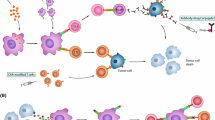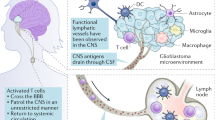Abstract
Many studies have suggested the possible existence of tumor-associated antigens in brain gliomas. Strong evidence for the existence of such cell determinants was provided by recent investigations using hybridoma technology. The possibility of obtaining monoclonal antibodies (MAbs) against glioma-associated antigens should help to allow their identification, purification, and characterization.
Utilizing MAbs as reagents of predefined specificity, a number of central and peripheral nervous system antigens could be detected. The molecules recognized by MAbs in glioma cells can be subdivided into four categories: [1] biochemical defined proteins, [2] specificities shared by nervous system-lymphoid cells, [3] oncoembryonic-oncofetal determinants, and [4] tumor-restricted antigens. Of greater significance is the heterogeneity of antigen expression among various individual glioma cells observed in frozen sections of tumor biopsies. Using a panel of MAbs, the phenotypic heterogeneity, i.e., the variation in antigen expression can be documented within and among malignant gliomas and cell lines derived from them. In spite of this the characteristic pattern of antibody binding to brain tumors makes MAbs the potentially best reagents for immuno-histochemical application in surgical neuropathology. Moreover, immuno-cytological screening of tumor cells in the cerebrospinal fluid has also proved to be valuable.
The localization of radio-labelled MAbs in experimental and human gliomas growing subcutaneously and intracranially in athymic nude mice were explored by radioscintigraphy and autoradiography. Imaging experiments with131I-labelled MAbs recognizing epitopes on the glioma cell surface showed high levels of specific activity in xenografts. Preliminary data indicate that administration of131I-MAbs as well as drug conjugates (daunomycin-MAbs) causes a depression of glioma cell proliferation in vitro as well as delayed tumor growth and thus prolonged survival time of tumor-bearing mice. The mechanisms of antibody delivery and transport of “immunotoxins” from the vascular compartment to intracerebral tumor tissue are presently a subject of discussion. The complexity of this area necessitates comprehensive experimental work in order to define the factors involved in the delivery of MAbs to brain tumor tissue and thus optimize the rate of blood-to-tumor transport. Current investigations have shown that it is possible to image malignant human gliomas using radio-labelled antibodies. The next step will be to attain target immunotherapy. The use of MAbs as carrier molecules for clinical applications might soon be possible.
Similar content being viewed by others
References
Ballou B, G Levin, RR Hakala, D Solter: Tumor location detected with radioactivity labeled monoclonal antibody and external scintigraphy. Science 206 (1979) 844–847
Bergh J, S Nilsson, D Stavrou, E Maripuu, A Epenetos: In vivo localization of human malignant gliomas utilizing an indium labelled monoclonal antibody (MUC 2-63). Abstracts of the 2nd Int. Conf. of Anticancer Res. Saronis, Greece Oct. 11–15 1988
Bigner D, S Bigner, J Ponten, B Westermark, M Mahaley, E Ruoslahti, H Herschman, L Eng, C Wirkstrand: Heterogeneity of genotypic and phenotypic characteristics of fifteen permanent cell lines derived from human gliomas. J Neuropathol Exp Neurol 40 (1981) 201–229
Bigner S, J Mark, D Bigner: Chromosomal composition of four permanent cultured cell lines derived from human gliomas. Cancer Genet Cytogenet 2 (1983) 335–351
Bigner S, P Burger, J Mark, D Bullard, D Bigner: Relationship beteeen karyotype and histologic parameters of malignant human gliomas. J Neuropathol Exp Neurol 43 (1984) 335
Bourdon MA, RE Coleman, RG Blasberg, DR Groothuis, DD Bigner: Monoclonal antibody localization in subcutaneous and intracranial human glioma xenografts: Paired-label and imaging analysis. Anticancer Res 4 (1984) 133–140
Bullard DE, DD Bigner: Applications of monoclonal antibodies in the diagnosis and treatment of primary brain tumors. J Neurosurg 63 (1985) 2–16
Bullard DE, CJ Adams, RE Coleman, DD Bigner: In vivo imaging of intracranial human glioma xenografts comparing specific with non specific radiolabeled monoclonal antibodies. J Neurosurg 64 (1986) 257–262
Carrel S, N de Tribolet, JP Mach: Expression of neuroectodermal antigens common to melanomas, gliomas and neuroblastomas. Acta Neuropathol (Berl) 57 (1982) 158–164
Coakham HB, PL Kornblith, EA Qundlen, LA Pollock, W Wood, LC Hartnett: Autologous humoral response to human gliomas and analysis of certain cell surface antigens: in vitro study with the use of microcytotoxicity and immune adherence. J Natl Cancer Inst 64 (1980) 223–233
Coakham HB, JA Garson, JT Kemshead, EZ Harper, B Brownell: Monoclonal antibodies to uncultured human astrocytomas. J Neuroimmunol 3 (1982) 238
Köhler G, C Milstein: Continuous cultures of fused cells secreting antibody of predefined specificity. Nature (Lond) 256 (1975) 495–497
Kornblith PL, FC Dohan, W Wood, BO Whitman: Human astrocytoma: serum-mediated immunologic response. Cancer 32 (1974) 1512–1519
Leong SPL, PD Noguchi, RE Cunningham, T Takami, JA Roth: Heterogenous expression of a murine B16 melanoma-associated antigen correlates with cell cycle. Cancer Immunol Immunother 24 (1987) 106–112
Levy NL, MS Mahaley, ED Day: In vitro demonstration of cell-mediated immunity to human brain tumors. Cancer Res 32 (1972) 477–482
Mahaley MS: Immunological aspects of the growth and development of human and experimental brain tumors. In: The Experimental Biology of Brain Tumors. Thomas, Springfield 1972
Martin B: Bindungseigenschaften monoklonaler Antikörper gegen Gliome des Menschen in vitro und in vivo. Vet. med. Dissertation, Universität München 1988
McComb RD, C Wirkstrand, MA Bourdon, S Bigner, D Bigner: Antigenic heterogeneity of human malignant gliomas demonstrated by reactivity with 10 monoclonal antibodies. J Neuropathol Exp Neurol 42 (1984) 308
de Muralt B, N de Tribolet, AC Diserens, D Stavrou, JP Mach, S Carrel: Phenotyping of 60 cultured human gliomas and 34 other neuroectodermal tumors by means of monoclonal antibodies against glioma, melanoma and HLA-DR antigens. Eur J Cancer Clin Oncol 21 (1985) 207–216
Neuwelt EA, WK Clark: CNS tumor immunology. In: Clinical Aspects of Neuroimmunology. Williams-Wilkins, Baltimore 1978
Nowell P: The clonal evolution of tumor cell populations. Acquired genetic lability permits stepwise selections of variant sublines and underlies tumor progression. Science 194 (1976) 23–28
Olsson L: Phenotypic diversity of malignant cell populations: Molecular mechanisms and biological significance. Cancer Rev 3 (1986) 91–114
Reichner H: Zur Frage der serologischen Unterscheidung zwischen infiltrierendem Neoplasma (Gliom) und normalem Gewebe des Hirns. Z Immunitätsforsch 80 (1933) 86–95
Roholl PJM, ASH de Jong, FCS Ramaekers: Application of markers in the diagnosis of soft tissue tumours. Histopathol 9 (1985) 1019–1035
Schnegg JF, AC Diserrens, S Carrel, RS Acolla, N de Tribolet: Human glioma associated antigens detected by monoclonal antibodies. Cancer Res 41 (1981) 1209–1213
Schold SC, D Bigner: Treatment of five subcutaneous human glioma tumor lines in athymic mice with carmustine, procarbazine and mithramycin. Cancer Treat Rep 67 (1983) 811–819
Seeger RC, HM Rosenblatt, K Imai, S Ferrone: Common antigenic determinants on human melanoma, glioma, neuroblastoma and sarcoma cells defined by monoclonal antibodies. Cancer Res 41 (1981) 2714–2717
Shapiro JR, WA Yung, GA Basler, WR Shapiro: Heterogenous response to chemotherapy of human gliomas grown in nude mice and as clones in vitro. Cancer Treat Rep 65 (1981) 55–59
Stavrou D: Mögliche immunologische Aspekte bei experimentellen neurogenen Tumoren. Zbl allg Path 120 (1976) 535
Stavrou D, AP Anzil, W Weidenbach, H Rodt: Immunofluorescence study of lymphocytic infiltration in gliomas. Identification of T-lymphocytes. J Neurol Sci 33 (1977) 272–282
Stavrou D, AP Anzil, H Elling: Tumor specific fluorescent and complement-dependent cytotoxic antibodies in the serum of rats with chemically induced brain gliomas. Acta Neuropathol (Berl) 43 (1978) 111–117
Stavrou D, M Hulten, AP Anzil, Th Bilzer: The humoral antibody response of rats immunized with chemically modified syngeneic brain cells and glioma cells. Int J Cancer 26 (1980) 629–637
Stavrou D, M Hulten, Th Bilzer: Chemical modification and antigenicity of glioma cells. Acta Neuropathol (Berl) Suppl VII (1981) 75–78
Stavrou D, Ch Süss: Hybridomas producing monoclonal antibodies against chemically induced gliomas. J Neuroimmunol 3 (1982a) 241
Stavrou D, Th Bilzer, M Hulten, K Zänker, AP Anzil, K Haglid, E Dahme: Immunological aspects of experimental brain tumors. Anticancer Res 2 (1982b) 151–156
Stavrou D, Ch Süss, Th Bilzer, U Kummer, N de Tribolet: Monoclonal antibodies reactive with glioma cell lines derived from experimental brain tumors. Eur J Cancer Clin Oncol 19 (1983) 1439–1449
Stavrou D, W Mellert, Th Bilzer, R Senekowitsch, E Keiditsch, P Mehraein: Radioimmunodetection of gliomas by administration of radiolabelled monoclonal antibodies. Anticancer Res 5 (1985) 147–156
Stavrou D, H Glässner, Th Bilzer, R Senekowitsch, E Keiditsch, P Mehraein: Radioimaging of experimental glioma grafts using F(ab′)2 fragments of monoclonal antibodies. Anticancer Res 6 (1986a) 897–904
Stavrou D, W Mellert, U Mellert, E Keiditsch, K Bise, P Mehraein: Growth inhibition of experimental glioma grafts by monoclonal antibody treatment. J Cancer Res Clin Oncol 112 (1986b) 111–118
Stavrou D, E Keiditsch, F Schmidberger, K Bise, I Funke, W Eisenmenger, R Kurrle, B Martin, U Stocker: Monoclonal antibodies against human astrocytomas and their reactivity pattern. J Neurol Sci 80 (1987a) 205–220
Stavrou D: Immunological aspects of brain tumors. In: Grundmann, E (ed): Cancer Campain Vol 10 Experimental Neurooncology, Brain Tumor and Pain Therapy. G. Fischer, Stuttgart—New York 1987b
Stavrou D, B Martin, U Stocker, V Kallmeyer, Th Bilzer, K Bise, E Keiditsch: Radioimmunoimaging of human glioma xenografts by external scintigraphy. Clin Neuropathol 7 (1988) 212–213
de Tribolet N, S Carrel: Human glioma tumourassociated antigens. Cancer Immunol Immunother 9 (1980) 207–211
Wikstrand CJ, DD Bigner: Expression of human fetal brain antigens by human tumors of neuroectodermal origin as defined by monoclonal antibodies. Cancer Res 42 (1982) 267–275
Wikstrand C, S Bigner, D Bigner: Demonstration of complex antigenic heterogeneity in a human glioma cell line and eight derived clones by specific monoclonal antibodies. Cancer Res 43 (1983) 3327–3334
Wikstrand C, F Grahmann, R McComb, D Bigner: Antigenic heterogeneity of human anaplastic gliomas and glioma-derived cell lines defined by monoclonal antibodies. J Neuropathol Exp Neurol 44 (1985) 229–241
Author information
Authors and Affiliations
Rights and permissions
About this article
Cite this article
Stavrou, D. Monoclonal antibodies in neuro-oncology. Neurosurg. Rev. 13, 7–18 (1990). https://doi.org/10.1007/BF00638887
Issue Date:
DOI: https://doi.org/10.1007/BF00638887




